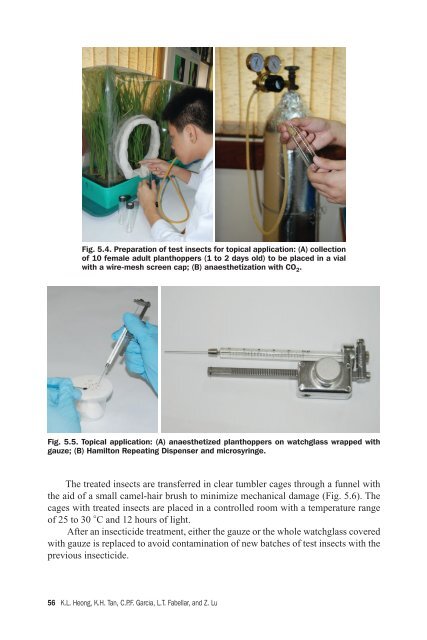Research Methods in Toxicology and Insecticide Resistance ...
Research Methods in Toxicology and Insecticide Resistance ...
Research Methods in Toxicology and Insecticide Resistance ...
You also want an ePaper? Increase the reach of your titles
YUMPU automatically turns print PDFs into web optimized ePapers that Google loves.
Fig. 5.4. Preparation of test <strong>in</strong>sects for topical application: (A) collection<br />
of 10 female adult planthoppers (1 to 2 days old) to be placed <strong>in</strong> a vial<br />
with a wire-mesh screen cap; (B) anaesthetization with CO 2 .<br />
Fig. 5.5. Topical application: (A) anaesthetized planthoppers on watchglass wrapped with<br />
gauze; (B) Hamilton Repeat<strong>in</strong>g Dispenser <strong>and</strong> microsyr<strong>in</strong>ge.<br />
The treated <strong>in</strong>sects are transferred <strong>in</strong> clear tumbler cages through a funnel with<br />
the aid of a small camel-hair brush to m<strong>in</strong>imize mechanical damage (Fig. 5.6). The<br />
cages with treated <strong>in</strong>sects are placed <strong>in</strong> a controlled room with a temperature range<br />
of 25 to 30 °C <strong>and</strong> 12 hours of light.<br />
After an <strong>in</strong>secticide treatment, either the gauze or the whole watchglass covered<br />
with gauze is replaced to avoid contam<strong>in</strong>ation of new batches of test <strong>in</strong>sects with the<br />
previous <strong>in</strong>secticide.<br />
56 K.L. Heong, K.H. Tan, C.P.F. Garcia, L.T. Fabellar, <strong>and</strong> Z. Lu

















